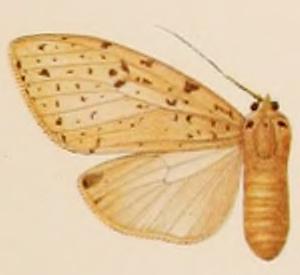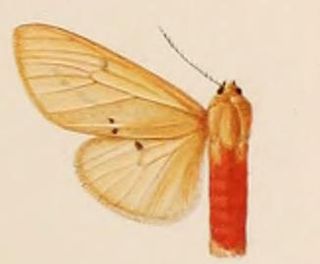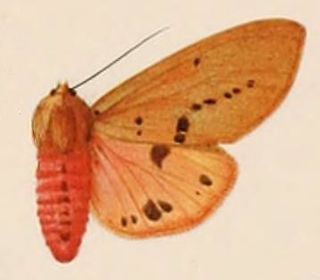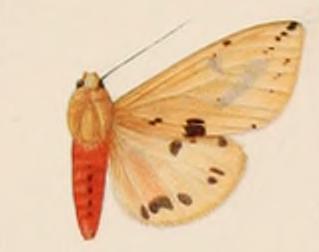
Papilio clytia, the common mime, is a swallowtail butterfly found in south and southeast Asia. The butterfly belongs to the subgenus Chilasa, the black-bodied swallowtails. It serves as an excellent example of a Batesian mimic among the Indian butterflies.

Semioptila is a genus of moths in the family Himantopteridae.
Merimnetria notata is a moth of the family Gelechiidae. It was first described by Lord Walsingham in 1907. It is endemic to the Hawaiian island of Molokai.

Rhodafra marshalli is a moth of the family Sphingidae. It is known from high, open country from Zimbabwe to Kenya.

Platyptilia campsiptera is a species of moth in the family Pterophoridae. This species is endemic to New Zealand. This species has been classified as Nationally Vulnerable by the Department of Conservation.

Lophocampa albescens is a moth of the family Erebidae. It was described by Walter Rothschild in 1909. It is found in French Guiana, Suriname and Venezuela.

Spilosoma semperi is a moth of the family Erebidae. It was described by Walter Rothschild in 1910. It is found on Sumatra and Peninsular Malaysia.

Spilosoma cajetani is a moth of the family Erebidae. It was described by Walter Rothschild in 1910. It is found on Seram Island.

Spilosoma roseata is a moth of the family Erebidae. It was described by Walter Rothschild in 1910. It is found on Java in Indonesia.

Spilosoma alberti is a moth of the family Erebidae. It was described by Walter Rothschild in 1914. It is found on Papua New Guinea, where it is restricted to mountainous areas at high altitudes ranging from 1,200 to 2,150 meters.

Spilosoma batesi is a moth of the family Erebidae. It was described by Walter Rothschild in 1910. It is found in Nigeria, Cameroon, Congo and Zaire.
Callidrepana albiceris is a moth in the family Drepanidae first described by Charles Swinhoe in 1907. It is found in Sundaland. The habitat consists of hill dipterocarp forests, limestone forests, lower montane forests an lowland forests.
Cathegesis angulifera is a moth in the family Gelechiidae. It was described by Walsingham in 1897. It is found on the West Indies.
Hypatima meliptila is a moth in the family Gelechiidae. It was described by Edward Meyrick in 1926. It is found in Papua New Guinea, where it has been recorded from New Ireland.
Arogalea crocipunctella is a moth of the family Gelechiidae. It is found in the West Indies, where it has been recorded from Saint Vincent.
Filinota hermosella is a moth in the family Depressariidae. It was described by August Busck in 1911. It is found in French Guiana.
Imma thyriditis is a moth in the family Immidae. It was described by Edward Meyrick in 1906. It is found on the Solomon Islands.

Semioptila flavidiscata is a moth in the Himantopteridae family. It was described by George Hampson in 1910. It is found in South Africa, Zambia and Zimbabwe.
Semioptila ansorgei is a moth in the Himantopteridae family. It was described by Walter Rothschild in 1907. It is found in Angola.
Semioptila torta is a moth in the Himantopteridae family. It was described by Arthur Gardiner Butler in 1877. It is found in the Democratic Republic of the Congo, Malawi, Mozambique, South Africa, Zambia and Zimbabwe.






